Introduction: In this article, Katie Rebecca Merkley continues her series exploring our ancestors and mentions of Easter in the newspaper, examining the period during the Civil War, 1861-1865. Katie specializes in U.S. research for family history, enjoys writing and researching, and is developing curricula for teaching children genealogy.
Continuing the Easter newspaper series, this installment focuses on newspapers from the Civil War period. There were many more search results for this period than the two previous ones in this series (see links at the end of this article). I searched GenealogyBank’s Historical Newspaper Archives for the keyword “Easter” and narrowed the results down to 1861-1865.
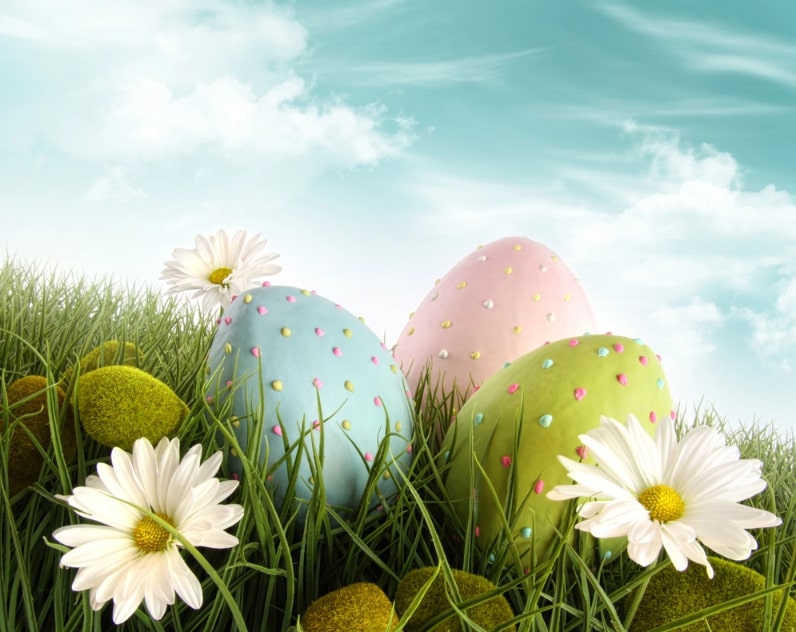
Photo credit: https://depositphotos.com/home.html
The 19th century and later newspapers have more columns than their earlier counterparts, and some were published more often. This suggests possible improvements in printing technology.
Additionally, the U.S. had expanded considerably between the Revolution and the Civil War, so there were more towns to produce newspapers. What was published in the newspaper reflects what was important to the communities back then. These articles on Easter show what our ancestors and their associates likely felt about Easter.
As discussed in the previous two articles in this series, newspapers during the colonial period mentioned Easter but the articles weren’t about the actual celebration of Easter. There seemed to be concern about the weather on Easter and calculating the date of Easter Day, as well as articles showing that Easter was a name used in various ways during this time. Finally, in the Civil War period, we see newspaper articles revealing how people celebrated Easter.
1861: Churches Adorned with Flowers for Easter
An Easter announcement posted a few days after the holiday in 1861 reveals a custom of that time: churches in the Unitarian sect were adorned with flowers at Easter and Christmas. What was unusual was that Reverand Doctor Furness’ Unitarian church had not participated in that tradition until that year.
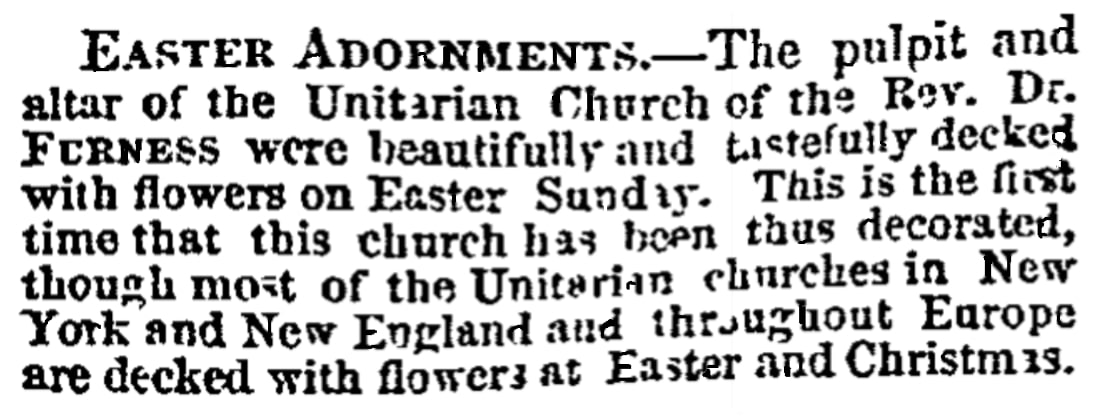
1862: Treats for the Holiday: Easter ‘Confections’!
The following year, Easter was 20 April, the same day as Easter this year (2025). Here is a newspaper ad for Easter confections. By 1862, sweet treats were a common enough Easter tradition that confectioners would market their treats for Easter.

1862: Interest in the History of Easter
Apparently, there was enough interest in Easter in 1862 that the editors of the Philadelphia Inquirer decided their readers would like a lengthy article about the history of Easter.
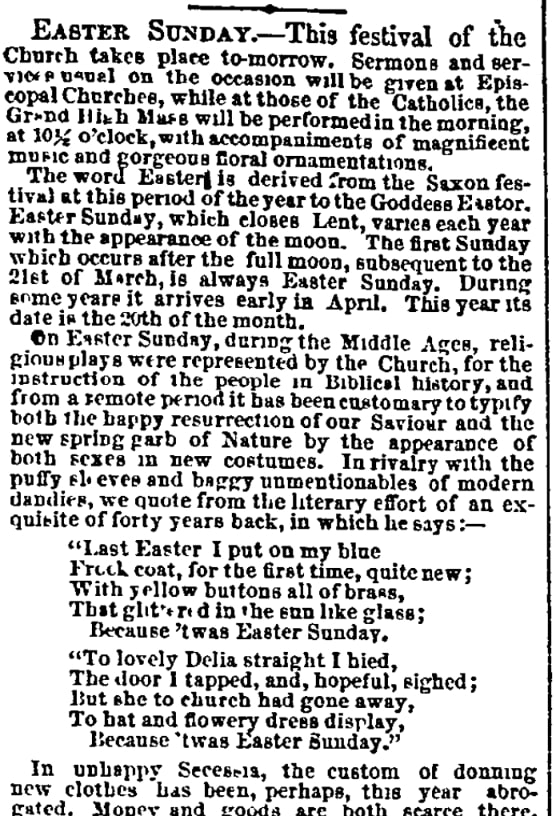
The first paragraph announces the church services to occur the following day at Episcopal and Catholic churches. The article then continues with a discussion on the history of the Easter festival. The word was derived from the Saxon festival at that time of year to the Goddess Eastor. In “the Middle Ages, religious plays were represented by the Church, for the instruction of the people in Biblical history.” Easter was a time to celebrate the resurrection of the Savior and “the new spring garb of Nature.”
The article discusses the tradition of wearing new clothes at Easter, which for women back then meant new Easter frocks and Easter bonnets:
[Women] have been in a state of exceeding excitement during the past week, to the distress of milliners and dry goods clerks, and to the painful experience of husbands and fathers.
The next part of the article is a paragraph about Easter eggs:
The use of Easter eggs dates far back in the Middle Ages. Its origin is not definitely known, but the inhabitants of Western Europe are said to have borrowed it from the Greek Church. Their crimson coloring is to represent the blood of Christ.
The remainder of the article describes the Easter programs of various Catholic churches in the city, including who’s speaking and what music will be played.
1864: Easter Concert
In 1864 in New York, an Easter concert was held by the Protestant Episcopal Church’s Orphan’s Home and Asylum. “The disagreeable weather did not prevent there being a large attendance.” The article lists the performances at the concert and, at the end, mentions a check of $100 payable to the Orphan’s Home and Asylum. The newspaper article was published on April 1, indicating that the concert occurred on March 31. Easter was on March 27 that year.
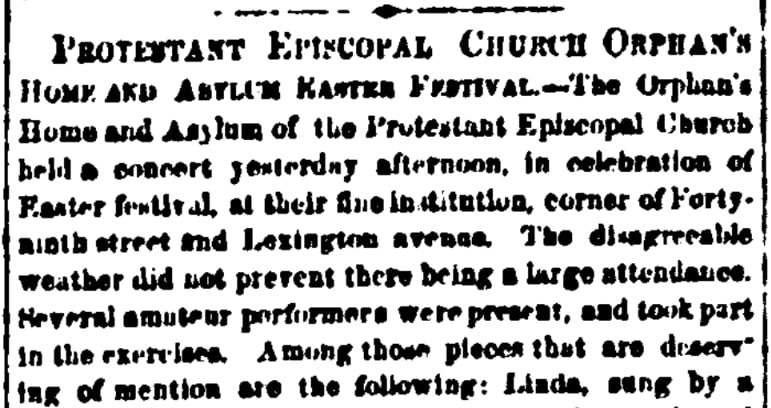
The article mentions that the Orphan’s Home and Asylum was on the corner of 49th Street and Lexington Avenue. Putting that intersection of New York City into Google Maps will show what that place looks like today, which is certainly different from what it was in 1864.
1865: Easter Music
An article posted the day before Easter in 1865 lists the music that some of the churches in New York City would be playing the next day. It lists the songs being played and the names of the choir members. This would be an interesting find for descendants of those choir members.
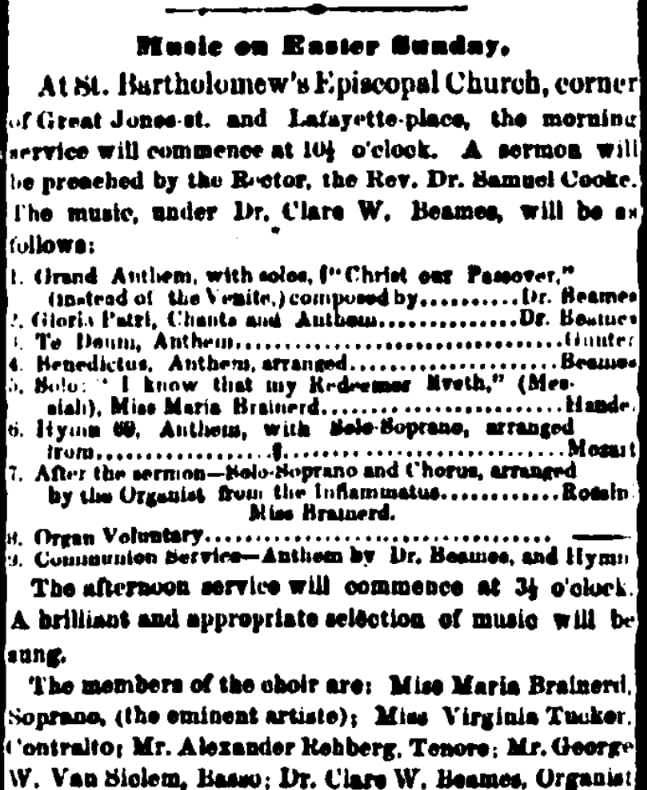
My husband and his family love music. All it takes to get my in-laws to burst into song is to sing one line of a song I sort of know. When I was dating my husband, his sister told me of one of their ancestors who crossed the plains to migrate to Utah and brought his piano with him. My in-laws inherited a love of music from their ancestors. Connections like this make family history personal. Newspapers may help you find common interests with your ancestors.
Based on this selection of articles, church attendance at Easter must have been important to our ancestors during the Civil War era. Even today, it’s an integral part of many people’s Easter celebrations. Even non-churchgoers who consider themselves Christian will typically attend church on Easter. Unlike newspapers during the colonial period, we see here during the Civil War that newspapers were publishing articles about flower decorations, Easter candy, and music played during the holiday.
Happy Easter and springtime!
Explore over 330 years of newspapers and historical records in GenealogyBank. Discover your family story! Start a 7-Day Free Trial
Note on the header image: Happy Easter. Credit: https://depositphotos.com/home.html
Related Articles:
